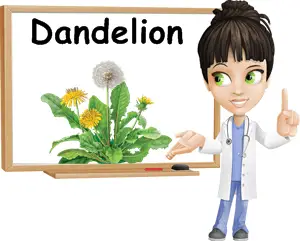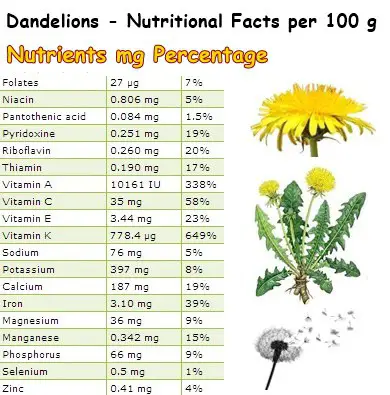Classified both as weed and medicinal herb, the common dandelion (Taraxacum officinale) is an incredible source of vitamins A, K and C, three essential nutrients with extraordinary health benefits.
Regular consumption is theorized to benefit cardiovascular and eye health and contribute to improved immunity. Moreover, their high nutritional value gives dandelions antioxidant and anti-inflammatory effects as well as hepatoprotective and detoxification benefits.
The flowers, seeds, leaves and root of the plant are of significant culinary and medicinal importance. While dandelion leaves (or dandelion greens) make a wonderful salad, and you can eat them both cooked and raw, multiple parts of the plant are used in different preparations, from herbal teas to extracts and decoctions, for various therapeutic uses (e.g. to purify the liver, treat dyspepsia, constipation, promote diuresis to lower blood pressure and bone and eye health). The herb boasts amazing antioxidant activity as well and helps in the prevention of chronic disease by keeping one in overall good physical health.

What are dandelions?
Dandelions are flowers, flowering plants to be more exact, native to Europe and Asia, but have successfully spread and established themselves throughout North America as well as many other regions of the world. Although in Antiquity they were the basis for a variety of herbal treatments, nowadays dandelions are regarded as weeds, mostly due to their invasive nature. Dandelions can be found everywhere from the side of the road to backyards, front lawns, parks, meadows and so on.
The common dandelion is also called blowball, priest’s crown, monk’s head, lion’s tooth, puffball, Irish daisy or white endive. The folk name lion’s tooth is a reference to the toothed leaves of the plant.
What do dandelions look like?
Dandelions are humble-looking plants, vigorous and easily adaptable due to their sturdy taproot. Although traits may differ according to species, the common dandelion is best known for its bright yellow flowers which mature into beautiful puff balls easily blown away by the wind. The whitish puff ball is actually the tuft fruit of the plant, containing up to 60-70 small brown seeds.
Can you eat dandelion flowers and root?
Dandelion stalks, leaves, taproots and flowers are all edible. The stalks of the plant contain a milky white sap or latex with powerful laxative properties, extremely useful for the prevention and treatment of constipation. In traditional medical practices, this milky sap is applied locally to help treat warts. The taproots (or main roots) are harvested for medicinal purposes during late summer and autumn. Usually, the roots, which are rather hard to pull out, are dried and ground into powder. They can be roasted and ground, then boiled in water to make a coffee substitute similar to chicory root.

Dandelion benefits and uses
Dandelion roots contain inulin and levulina. Inulin is a type of carbohydrate and soluble fiber found in dandelion roots, chicory, garlic, onions and bananas which promotes colon health because it stimulates the growth of good gut bacteria such as Lactobacilli and Bifidobacteria while inhibiting the growth of dangerous gut bacteria (read more about the benefits of chicory).
Multiple studies show that it may also stimulate the immune system response in infants and decrease triglyceride levels. According to researchers, inulin helps the body rehydrate and recover after mild to severe episodes of diarrhea, thus contributing the the great tonic effect of dandelions.
Preliminary research suggests that dandelion roots have a strong hepatoprotective action. Other plants said to prevent liver damage are turmeric and mustard. Dandelion herbal tea is known to be a great diuretic, promoting the elimination of toxins from the body. The diuretic properties are attributed to the compound known as taraxacin.
Eating dandelions is not only safe, but also recommended. It is said that they increase appetite and help treat indigestion, or dyspepsia. Indigestion symptoms may vary immensely from early satiation to recurrent pain in the abdomen area, bloating, heartburn, belching or even nausea. Traditional medical practices recommend treating indigestion with infusions of dandelion flowers.

Need to know: it is best to avoid picking dandelions from the side of the road or fields near factories or commercial crops. The strong roots of the plant easily absorb everything put in the ground around them, including traffic pollution, pesticides, weed killers or carcinogenic chemicals. A good solution would be purchasing dandelion tea from the supermarket or picking the flowers from more pristine areas, cut off completely from the reach of plants, factories etc.
Dandelion greens are an important source of vitamins A, K and C. The leaves are rich in flavonoids such as beta-carotene, alpha-carotene, lutein, zeaxanthin and cryptoxanthin as well as essential minerals. With 650% of the RDA of vitamin K, they stimulate calcium absorption and thus support bone and teeth health, prevent atherosclerosis, reduce inflammation levels and coronary heart disease risks.
Around 100 g of leaves provide 338% of the RDA of vitamin A and 58% of the RDA of vitamin C, two potent antioxidant-vitamins. While vitamin C prevents wrinkles and boosts immunity, vitamin A alongside beta-carotene, lutein and zeaxanthin promote eye health.
The leaves, said to be the richest in essential nutrients of all the plant and called dandelion greens or tops, have a slightly bitter taste, similar to that of mustard greens. Young dandelion greens are eaten raw in salads or with boiled eggs, similar to spinach, while more mature leaves are boiled, sauteed or deep-fried and enjoyed as side dish. Dandelion herbal tea is a great tonic and can easily calm down an upset stomach and treat indigestion. Dandelion roots make a great coffee substitute after being roasted and grounded into powder. The flower pollen and nectar are the source of therapeutic dandelion honey.
Dandelion side effects and contraindications
Because dandelions belong to the daisy family, they can trigger an allergic reaction in people allergic to to Asteraceae plants. Daisy family plants are known allergens and account for an important percentage of food allergies. Chamomile, Echinacea and sunflower are also members of the same family and report similar side effects. Although there have been very few reported cases of dandelion allergy, the allergenic potential is real. So if you suspect an allergy to dandelion or are aware you are allergic to other daisy family plants, avoid them in all forms and preparations.
You can ask your doctor to perform an allergy test, either a simple skin prick test or a blood test looking for antibodies, to confirm or rule out an allergy before proceeding to consuming dandelion in any form. If you experience any allergy symptoms following consumption of dandelion in any form, such as a skin rash, swelling of the lips, tongue or throat, difficulty breathing from the swelling, wheezing, hoarseness, coughing or closing of the airways, seek medical help immediately before the symptoms evolve to anaphylactic shock.
